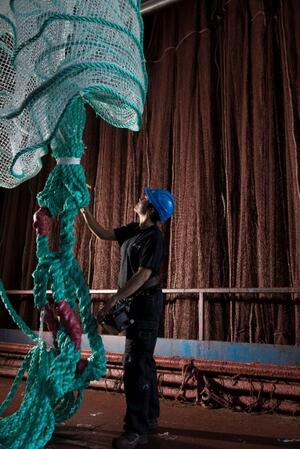
A clean net in the sea is perhaps a dream that is difficult to fulfill. If we go back a few years, the purpose of net treatment was, among other things, to ensure a good supply of oxygen to the fish. For us as net manufacturers, the net treatment is also very important to protect the net line from damage and wear. Today, the main challenge is to have as clean a net as possible at all times so that the cleaner fish do not eat the net instead of eating lice. In addition, as an alternative to net treatment, the fish farmers have to clean (high-pressure washer) the net in the sea, which they do not want for reasons of diet and reasons of fish health.
AKVA group Egersund Net, as a producer of nets, spends some time each year evaluating new products, also from the three Norwegian producers, Steen Hansen, Netkem and Brynsløkken, which delivers products to the aquaculture industry. We have test panels in the sea to check new products against existing products. In parallel, we must test, among other things, application ability and HSE conditions.
Challenges of net flushing
For those who do not replace the net, continued cleaning in the sea is necessary in most cases. This is a big challenge as it negatively affects the fish. We know that cleaning can deteriorate the health of the fish, with a negative impact on the gills. When amoebic gill disease attacks the fish, it is hit hard. Although there has been a significant development in net cleaning in the sea, you still want to avoid this. There are also other challenges with flushing, such as the spread of organic and inorganic materials.
Previously, high flushing pressure was used when cleaning nets at sea. In some cases, this caused great damage to our nets and fortunately, manufacturers together with the industry have developed the technology so that easy cleaning with low pressure is the norm today. Cleaning methods other than flushing have also come on the market today.
Copper-based net treatment has been used for more than 35 years as an active biocide to reduce fouling on nets, and replaced in the 80s and 90s toxic additives such as Irgarol and organic tin compounds such as TBT (tin). Until recently, copper has in principle been the only alternative on the market, apart from coating which is free of biocides. As is known, this type of treatment is also used on boats and ships below the waterline to reduce fouling and thus reduce fuel consumption. Both authorities and users have extensive experience with copper for many years, and we know the negative sides. The fish farmers are currently experiencing great pressure from the authorities, in some counties in Norway, concerning the amount of copper in the bottom sediments, which in some places is starting to become high.

Hanging up a net in Egersund, Norway.
New development by producers
Steen Hansen has set itself a goal, and that is to reduce the amount of copper in its products. They are well on their way to seeing the effects of this and can today offer anti-growth products without copper. The active biocide they use instead of copper is then zinc pyrithione and tralopyril, also called Econea.
Netkem is still using copper, although they are also working with alternatives. They believe that the correct use of copper-based products is safe for the fish and the environment. They have prepared an informative video which can be viewed here.
Brynsløkken is also working on new products and it will be exciting to see what they come up with in the future.
Based on AKVA group Egersund Net's consumption of net treatment products in 2019, we have today reduced copper-based products by approx. 62 %. Then we also sell coatings that are free of biocides. AKVA group Egersund Net works actively to ensure the proper and safe use of all impregnations and coatings, both with and without biocides. At Austevoll, Norway, as one of the first service stations in the country, we now only offer net treatment products without copper.
